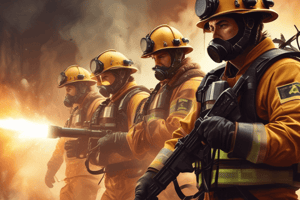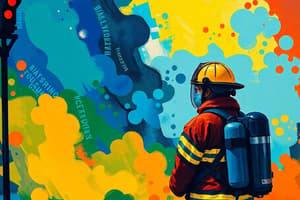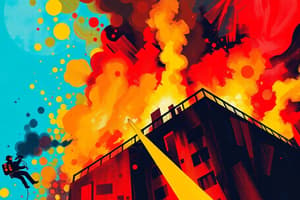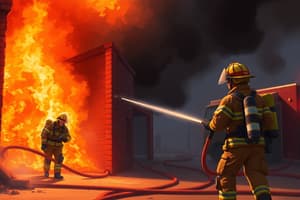Podcast
Questions and Answers
What is the standard aggressive interior fire attack intended to primarily achieve?
What is the standard aggressive interior fire attack intended to primarily achieve?
- Prioritizing the safety of firefighters above all other concerns.
- Increasing the chances of saving lives and property effectively. (correct)
- Following a defensive strategy before offensive actions.
- Ensuring quick extinguishment of the fire, regardless of risk.
In the context of structural firefighting, what does the acronym 'IDLH' stand for?
In the context of structural firefighting, what does the acronym 'IDLH' stand for?
- Incident Directing Life and Health
- Immediately Direct Life Hazard
- Incident Demanding Life and Health
- Immediately Dangerous to Life and Health (correct)
When performing a scene size-up, what action should be taken if a complete 360-degree assessment of the incident cannot be achieved?
When performing a scene size-up, what action should be taken if a complete 360-degree assessment of the incident cannot be achieved?
- Proceed with interior operations cautiously.
- Rely on pre-incident plans and historical data.
- Notify incoming units and communications of the inability to complete the assessment. (correct)
- Request immediate assistance from a drone unit.
When employing a “Passing Command” mode, what primary responsibility does the initial Company Officer retain?
When employing a “Passing Command” mode, what primary responsibility does the initial Company Officer retain?
How many 3" supply lines are required for anticipated water flows of 600 GPM?
How many 3" supply lines are required for anticipated water flows of 600 GPM?
What should be considered when a primary search yields unclear results?
What should be considered when a primary search yields unclear results?
Which action should be prioritized if a fire is deemed suspicious during overhaul?
Which action should be prioritized if a fire is deemed suspicious during overhaul?
During an electronic fire alarm investigation with no visible signs of smoke, heat, or fire, what is the standard procedure for the first due company?
During an electronic fire alarm investigation with no visible signs of smoke, heat, or fire, what is the standard procedure for the first due company?
What is a key safety consideration when dealing with parking structures?
What is a key safety consideration when dealing with parking structures?
What is a primary risk factor associated with buildings under construction that firefighters should be aware of?
What is a primary risk factor associated with buildings under construction that firefighters should be aware of?
Flashcards
Purpose of SOGs
Purpose of SOGs
To provide personnel with a safe and effective guideline for fire scene operations.
Standard Fire Attack
Standard Fire Attack
An aggressive interior fire attack properly performed increases the chances of saving lives and property.
RIT Establishment
RIT Establishment
A Rapid Intervention Team (RIT) will be established on any Immediately Dangerous to Life and Health (IDLH) incident.
Incident Objectives
Incident Objectives
Signup and view all the flashcards
Tactical Objectives
Tactical Objectives
Signup and view all the flashcards
Thermal Imager Camera (TIC)
Thermal Imager Camera (TIC)
Signup and view all the flashcards
Apparatus Placement Factors
Apparatus Placement Factors
Signup and view all the flashcards
Water Supply Options
Water Supply Options
Signup and view all the flashcards
Ventilation Options
Ventilation Options
Signup and view all the flashcards
Building Under Construction Risks
Building Under Construction Risks
Signup and view all the flashcards
Study Notes
- A safe and effective guideline for fire scene operations is provided for personnel
- Aggressive interior fire attack is the standard operating procedure for the St. Lucie County Fire District
- Properly performed interior fire attacks increase the chances of saving lives and property
- The Risk Assessment must be evaluated before starting interior operations
- Incident Objectives and Tactical Operations must be evaluated before, during, and after any emergency incident using scene size-up
Incident Objectives include:
- Life Safety
- Incident Stabilization
- Property Conservation
- Environmental Conservation
Tactical Operations include:
- Rescue
- Exposure
- Confinement
- Extinguish
- Overhaul
- Ventilation
- Salvage
- Ventilation and Salvage may be performed at any time based on conditions
- A Rapid Intervention Team (RIT) will be established on any Immediately Dangerous to Life and Health (IDLH) incident
Size-up
- A well-communicated scene size-up by the first arriving unit should paint a picture of the scene to better prepare other incoming units
- A brief scene size-up is followed by a 360 degree of the incident to identify any unseen hazards
- Side "Alpha" is identified by geographical location and relayed to all incoming units
- If a complete 360 degree of the incident is not possible, incoming units and Communications must be notified
- Thermal Imager Camera (TIC) is a primary tool to be used during size-up, fire attack, search and rescue, and overhaul
- A 5 part arrival report is the basic template utilized for incident size-up
Basic template utilized for incident size-up:
- Who are you?
- Describe the building.
- What do you have?
- What are you doing?
- What do you need?
Confirmed Structure Fire (working fire):
- The initial Company Officer or Incident Commander (IC) must announce over the radio, "we have a confirmed structure fire". The fire must have structural involvement, hose lines pulled, and water flowing
- Factors to consider when positioning apparatus with the following:
- Overall Objectives
- Fire Extent and Location
- Water Source
- Type of Structure
- Structural Integrity
- Additional Resources
- Overhead Power Lines
- Contents- Explosives, Hazardous Materials, etc.
- Avoid placing apparatus in the collapse zone (one and a half times the height of the building).
Command Options
- An incident that requires only the response of one company, and is not expected to escalate beyond the commitment of this company, does not require the formal activation of the Incident Command System (ICS)
- Formal activation of the ICS is required for any incident involving two or more companies, in the judgment of the on-scene ranking officer, or an incident that has the potential for escalation
- Nothing Showing – Investigative Mode: These situations generally require investigation by the initial arriving Company while other units stage and await an assignment
- Passing Command - Immediate Action Mode: The first arriving Company Officer can work with their company in a "Passing Command" mode which allows the next arriving Officer to establish command
Immediate Action Mode ends when:
- Situation is stabilized
- Situation is not stabilized and the Company Officer must withdraw to the exterior
- Command is transferred to another on-scene Company or Chief Officer
- Establishing Command - Command Mode: The initial IC shall establish command and name the incident and will remain in command until it is transferred or the incident is stabilized and terminated.
- All fire ground operations should go through command, with the exception of imminent life safety hazards, and the level of accountability must be communicated over the radio
Level 1:
- Personnel Accountability Tag (PAT) placed on the Unit Identification Pad (UIP) of the apparatus to which personnel are assigned
Level 2:
- UIP placed on the designated Tactical Accountability/Entry Board (TAEB)
Level 3:
- Personnel that are making entry into the hazardous area are to remove a second PAT and attach it to the entry board at the controlled entry point.
Water Supply Options:
-
Forward Lay - hose is laid from the water source to the fire.
-
Reverse Lay - hose is laid from the fire to the water source.
-
Supply lines should be a minimum of 3" diameter
- Anticipated water flows of less than 500 GPM will require one (1) 3" supply line
- Water flows of 500-1000 GPM will require two (2) 3" supply lines
- Water flows of 1000-1500 GPM will require three (3) supply lines
-
First Due Tanker – Will be placed in a location as near as possible to the attack engine with egress for refill a priority
-
Second Due Tanker – If a water shuttle evolution is implemented, the IC may call for another engine to hook up to the nearest source of water supply to rapidly refill the tankers
-
A four-way valve (Humat) will be placed on the 4 1/2" hydrant outlet when a first due engine establishes their own water supply
-
Consideration should be given to laying two lines when a large volume of water is needed
-
An independent, secondary water source may be needed to supply apparatus for defensive operations, aerial devices and large fire volume
Pressurized Water Extinguisher (“water can”):
-
Should be considered when nothing is showing upon arrival (investigative mode)
-
When there is an indication of viable life and the structure is still tenable, but a hoseline is not yet available
-
Life safety is the highest tactical priority
-
The IC should consider the potential for rescue at all times
-
The IC must determine the course of action to ensure the best outcome for occupants based on the conditions at that time
-
In a multiple story building the immediate fire area and the floor above the fire are the search and rescue priorities
-
A rapid primary search is initiated when there is an indication of viable life and the structure is still tenable
-
Searches should be based on reported victim location, the area closest to the fire, the largest number of possible victims, and then the remainder of the structure
Common types of searches include:
- Right-hand
- Left-hand
- Targeted
- Orientated
- Wide area
- A secondary search of the structure should be performed when conditions allow and should be performed by a different crew than the primary search
- An aggressive interior attack is the standard offensive attack
Company Officers should do the following:
- Identify the location and extent of the fire
- Select the appropriate tactics to overcome the volume of fire.
- The initial attack lines have the greatest impact on the outcome of the incident
- A backup hoseline should be deployed equal or greater than the attack line.
- Exposure protection should become a priority for defensive attacks
- Multiple means of egress should be provided and controlled before any interior operations take place
- There are several reasons to ventilate a structure: increase survivability for victims, change fire direction, stop a fire from moving, and to decrease smoke and heat for interior crews
- Ventilation should be coordinated with fire attack through the IC and the fire attack group
- Firefighters assigned to ventilate a structure should bring appropriate tools with them to the structure
These tools included but are not limited to:
- Chainsaw
- Reciprocating saw
- Flat-head axe/Halligan bar ("irons")
- Pike pole/roof hook
- K-12, flashlights, hoseline, and ladders.
- Salvage operations can often be started at the same time as fire attack and are aimed at preventing or limiting secondary losses and help reduce the extent of loss and facilitate prompt restoration of the property to full productive use. PPE is to be worn at all times
- The building and its contents are to be left in as safe and habitable condition as possible and the use of a wetting agent should be considered during overhaul operation
Apparatus Placement:
- Single Resource Response - The first due apparatus will position on the "Alpha" side of the structure, allowing the officer to see three sides
- The officer should indicate what side of the structure the apparatus is positioned over the radio so that incoming units can orient themselves to the incident
- Multiple Resource Response - These situations generally require investigation by the initial arriving Company while other units stage and await an assignment
- Apparatus must be positioned so they allow for expansion of the operation
- Electronic fire alarms require firefighter safety, life safety, structural stability, securing utilities, and accounting for the incident scene
Water Supply is important to consider
- With no report of smoke, heat, or fire, a water supply does not have to be established but the location of a water supply should be known
- Most electronic fire alarms are of an investigative nature. With no sign of smoke, heat, or fire it is not necessary to pull an attack line
Fire Suppression Operations:
- Requires these safety considerations, firefighter safety, life safety, structural stability, securing utilities.
- Level 2 accountability, the building or situation dictates a higher level
- The Safety Officer will ensure that an Accountability Officer has been assigned.
Fire Suppression Apparatus Placement:
- First due apparatus should position itself so the officer gets a look at three sides of the structure, if feasible
- Apparatus placement at large commercial buildings and high-rise structures must leave room for aerial apparatus to effectively deploy
- Aerial apparatus should be placed in the most effective position for ladder use for rescue, upper level access, or ladder pipe operations
- A constant water supply should be established as soon as possible and Units responding to the scene need to remain cognizant of hydrant locations, water supply options, and the need to establish and secure a water supply
Fire Suppression Forcible Entry:
- Initial entry should be made through the most advantageous point and once an opening has been made in the structure, most commonly a door, it should be considered a ventilation point and needs to be controlled (closed) until the attack team is prepared to enter
Ventilation options include:
- Horizontal - Opening of doors and windows
- Vertical - Roof openings will be a minimum of 4' X 4' if structurally possible
Commercial Structures safety:
- Level 2 accountability, the building or situation dictates a higher level
- Consult any pre-incident survey for the structure
- Consider evacuating occupants and be aware of escape routes and Identify lightweight truss and floor placards.
- The first arriving apparatus should be positioned at the front of the structure
- Large commercial buildings and high-rise structures must leave room for aerial apparatus
- BIG FIRE = BIG WATER! Is identification of fire department connections (FDC) and hydrant locations early in the incident
- Commercial doors are often fortified and power tools may be needed for the forcible entry
- Consider preexisting openings such as scuttles, skylights, and HVAC systems during ventilation
- Designate a designation for evacuation and attack stairwells in multi-story commercial structures Parking Structures
Parking Structure Safety Considerations:
- Level 2 accountability, unless the situation or building dictates a higher level
- Lack of visibility
- Moving vehicles
- Traffic control
- Low ceilings
- Limited entry and egress
- Auto extension to levels above the fire
- Fuel runoff
- Exposures
- Structural stability
- Extended hose lays and use of a wetting agent may be required
Abandoned Buildings and/or Buildings Under Construction require these safety considerations
- Level 2 accountability, unless the situation or building dictates a higher level
- Structures that have no local owner or landlord are considered abandoned
Buildings under construction risks
- Lack of a fire protection system
- Delayed fire detection
- Rapid fire spread
- Early collapse
- Hydrants and fire suppression systems may not be operational
Studying That Suits You
Use AI to generate personalized quizzes and flashcards to suit your learning preferences.




